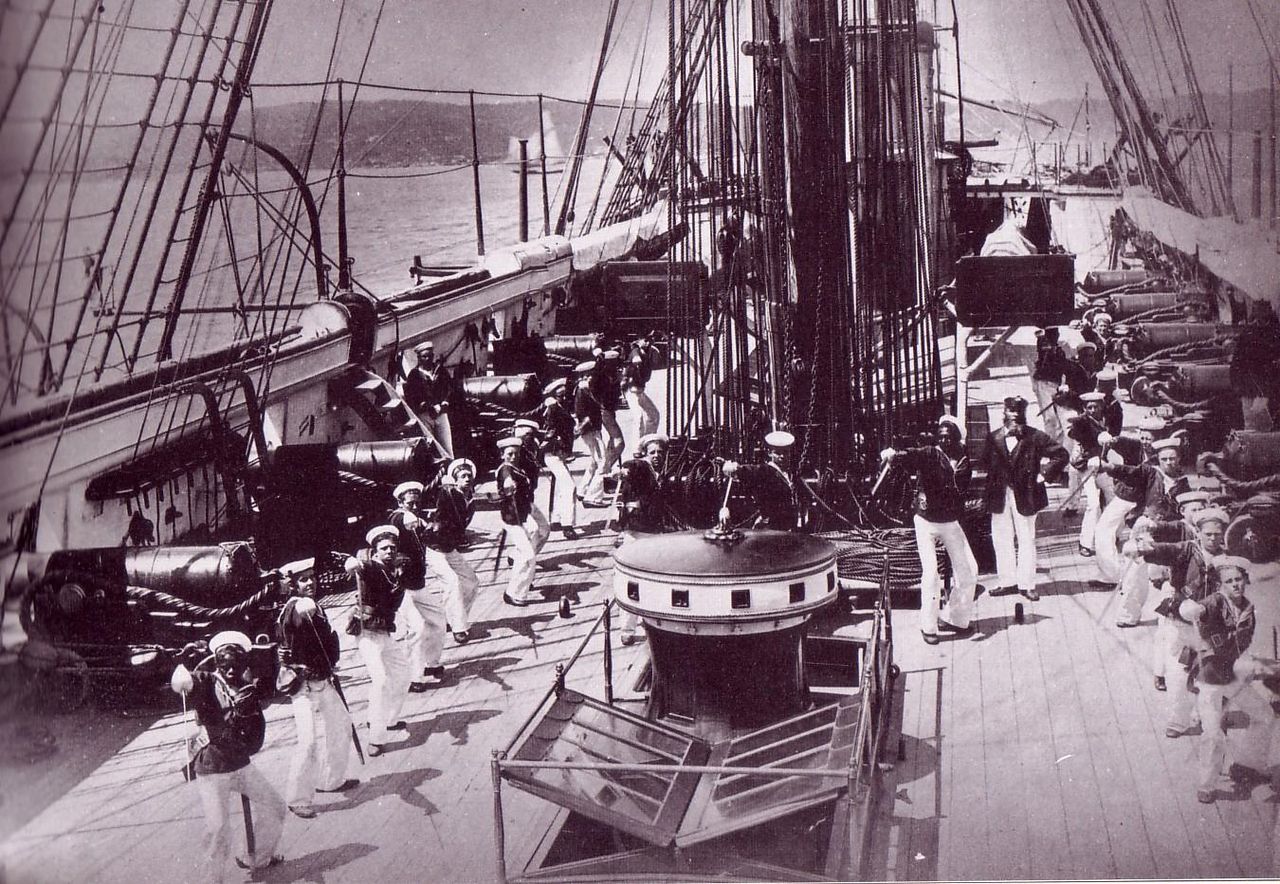|

A cutlass is a short, broad sabre or slashing sword with a straight or slightly curved blade sharpened on the cutting edge and a hilt often featuring a solid cupped or basket-shaped guard. It was a common naval weapon during the early Age of Sail.
In
this John
Storm adventure, the Elizabeth
Swann features a pair of antique cutlasses in the forward helm. Dan
Hawk and John engage in playful sword fighting using these weapons. The
sparring partners realising the John is a natural, and extremely skillful buccaneer.
THE CUTLASS: THE SWASHBUCKLER'S BLADE
Few weapons evoke the raw romance, brute practicality, and unmistakable spirit of piracy like the cutlass. With its short, curved blade and distinctive guard, the cutlass not only carved a niche on the high seas but also became a symbol of defiance and survival in the cramped, chaotic world of wooden ships.
A Weapon Born of Necessity and Design
Emerging from a lineage of medieval blades like the falchion, the cutlass was honed over centuries to meet a singular need: effectiveness in close-quarters combat. Unlike the longer, more elegant swords of knights and gentlemen, the cutlass was designed to be compact, easily wielded, and versatile. Measuring roughly 24 to 30 inches in length, its slight curve allowed for swift, powerful slashes—perfect for the mayhem of boarding actions, where space was at a premium and every swing could be a life-or-death matter .
Versatility Aboard Ship
On a pirate ship, every tool had to earn its keep. The cutlass could serve many purposes:
Combat: In the heat of a boarding fight, the cutlass’ short reach was an asset. In the narrow corridors and on the slippery decks of a ship, a long sword would be unwieldy; a cutlass, by contrast, could be swung with rapid precision, slicing through rigging or an opponent’s defenses with equal ease.
Utility: Beyond battle, its robust design transformed it into a multipurpose tool. Pirates used cutlasses to cut through thick ropes, slash through heavy canvas when adjusting sails, or even clear brush on remote, uncharted islands. This dual functionality meant the cutlass was never far from a sailor’s hand—always at the ready whether for work or war.
Why Pirates Favored the Cutlass
The cutlass’ popularity among pirates wasn’t solely due to its physical attributes; it was also an instrument that suited the lifestyle and values of seafaring marauders.
Intimacy of Engagement: In the confined quarters of a ship, where every man fought shoulder-to-shoulder and every movement was heightened by the threat of death, a weapon that could be easily drawn and wielded was more practical than a cumbersome rapier or broadsword. The cutlass delivered brutal efficiency—quick, decisive, and ideally suited to the constant close combat of pirate skirmishes.
Ease of Training: Formal fencing and swordplay required rigorous training. Most pirates, improvised outlaws with little time or desire for formal instruction, benefited from the simple, robust design of the cutlass. Its straightforward nature meant that even untrained hands, through sheer necessity and repeated use, could master its strikes without years of refinement.
Symbol of Rebellion: The cutlass was more than just a tool—it was an emblem of authority and menace. Pirate captains and crews alike carried the weight of myth with every cutlass swing. Legends grew from the mere sight of a pirate gripping their cutlass, evoking the tales of notorious figures like
Blackbeard and
Captain
Kidd, who wielded the blade as both a weapon and a symbol of their defiant rebellion against the established order.
Anne Bonny, one of the few well-documented female pirates, is frequently portrayed with a cutlass in popular depictions, emphasizing the weapon’s reach across gender in pirate crews, though direct documentation of her specific weaponry remains scarce.
Practical Adaptation: The cutlass was an evolution of design tailored to the harsh environment of the sea. Its curved blade was not only functional in combat but also symbolized the adaptability and resourcefulness needed by pirates to survive. It represented a rugged simplicity—an unfussy tool that got straight to the point, unlike the ornate swords of nobility.

The Myth and Legacy of the Cutlass
Over the years, the cutlass has transcended the boundaries of a mere naval weapon to become an icon of adventure and resistance. Folk songs, maritime folklore, and even modern-day films continue to immortalize its role. Characters brandishing a cutlass evoke the enduring spirit of those who braved uncharted waters for treasure, freedom, and a taste of anarchy.
The cutlass’ evolution from a medieval sword to the quintessential pirate weapon mirrors the transformation of piracy itself—from rogue privateers operating under the banner of rebellion to the larger-than-life figures that have captivated our imaginations. Its storied past, filled with legends of daring feats and blood-soaked battles, cements its place not just in naval history but in the cultural mythos of seafaring lore.
ETYMOLOGY
The word "cutlass" developed from the 17th-century English use of coutelas, a 16th-century French word for a machete-like mid-length single-edged blade (the modern French for "knife", in general, is couteau; in 17th- and 18th-century English the word was often spelled "cuttoe"). The French word coutelas may be a convergent development from a Latin root, along with the Italian coltellaccio or cortelazo, meaning "large knife". In Italy, the cortelazo was a similar short, broad-bladed sabre popular during the 16th century. The root coltello, for "knife", derived ultimately from the Latin cultellus meaning "smaller knife", which is the common Latin root for both the Italian and French words.
In the English-speaking Caribbean, the word "cutlass" is also used as a word for machete.

HISTORY
AND USE
The cutlass is a 17th-century descendant of the edged short sword, exemplified by the medieval falchion.
Woodsmen and soldiers in the 17th and 18th centuries used a similar short and broad backsword called a hanger, or in German a messer, meaning "knife". Often occurring with the full tang (i.e. slab tang) more typical of daggers than swords in Europe, these blades may ultimately derive through the falchion (facon, falcon, fauchard) from the falx or seax.
In England, about 1685 the rather long straight-bladed sword formerly in use began to be superseded by the "hanger". This weapon had a short and more or less curved single-edged blade with a brass hilt of a rather flat double-shell and knuckle-bow. The grip was generally of wood, bound with wire, but some specimens show a brass grip with spiral grooves. These are probably early models. The length of the blade is usually about 24 inches (61 cm).
HISTORY
Although also used on land, the cutlass is best known as the sailor's preferred weapon, as it was robust enough to hack or cut through heavy ropes, thick canvas, and dense vegetation while being short enough to be used in relatively close quarters combat, such as during boarding actions, in the rigging, or below decks. Another advantage to the cutlass was its simplicity of use, as it required less training than that required to master a rapier or small sword.
Cutlasses are famous for being used by pirates, although there is no reason to believe that
Caribbean buccaneers invented them, as has occasionally been claimed. However, the subsequent use of cutlasses by pirates is well documented in contemporary sources, notably by the pirate crews of William Fly, William Kidd, and
Stede
Bonnet. French historian Alexandre Exquemelin reports the buccaneer François l'Ollonais using a cutlass as early as 1667. Pirates used these weapons for intimidation as much as for combat, often needing no more than to grip their hilts to induce a crew to surrender, or beating captives with the flat of the blade to force their compliance or responsiveness to interrogation.
Owing to its versatility, the cutlass was as often an agricultural implement and tool as it was a weapon (cf. machete, to which the same comment applies). It was used commonly in rain forest and sugarcane areas, such as the Caribbean and Central America. In their most simplified form they are held to have become the machete of the
Caribbean.
The leadcutter sword was a weapon modelled on the cutlass, designed for use in shows and demonstrations of swordsmanship in the late Victorian era. Wilkinson Sword made these swords in four sizes, no. 1 to no. 4, of increasing weight to suit the strength of the user. The leadcutter was so named because in demonstrations it was used to cut a lead bar in half. Wilkinson included a mould for the lead bar with each purchase of their swords.
CONCLUSION
The cutlass remains a potent symbol of maritime tenacity—a simple yet fearsome weapon that reflects the challenges of life at sea.
Beloved by pirates for its practicality, versatility, and raw power in tight quarters, its curved blade tells a story of practicality infused with rebellion. In every gleaming edge and every battle-worn scar, the cutlass whispers of days when pirates ruled the waves with audacity and skill, forever etching their legacy into the annals of history.
|


